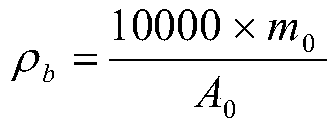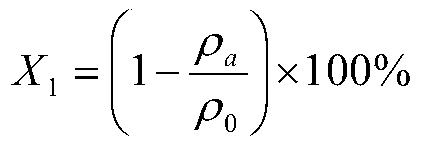Electrolyte resistant wrinkle lithium ion battery diaphragm preparation method and prepared diaphragm
A lithium ion battery and electrolyte technology, which is applied in the preparation of anti-electrolyte wrinkle lithium ion battery separators, and the field of anti-electrolyte wrinkle lithium ion battery separators, can solve the problems of complexity and great influence on battery performance, etc.
- Summary
- Abstract
- Description
- Claims
- Application Information
AI Technical Summary
Problems solved by technology
Method used
Image
Examples
Embodiment 1
[0066] (1) Raw material preparation: the polypropylene raw material with a melt index of 0.8 g / 10 min, an isotacticity of 98%, and a number average molecular weight of 420,000 was used.
[0067] (2) Diaphragm preparation: the polypropylene raw material is melt-extruded by using a single-screw extruder with an aspect ratio L / D≥34, and the extrusion temperature is 230°C. The melt is coarsely filtered, precisely metered, and finely filtered, and then cast into a film through a forming die with an opening of 2mm, and cooled to 80°C by a casting roll with a diameter of 700mm to form a cast film with high crystallinity and orientation. Thin film diaphragm. The diaphragm is further wound after traction, on-line thickness measurement, surface defect treatment, edge trimming. The thickness of the diaphragm is 10-15 microns, and the thickness uniformity is ±0.1 microns. The extrusion screw is preferably a separating screw, which can separate the fully plasticized or not melt, transpor...
Embodiment 2
[0074] This embodiment adopts the polypropylene raw material that melt index is 1.0g / 10min, isotacticity is 98.5%, and number average molecular weight is 440000, and adopts the same technological step as embodiment 1, and wherein cold drawing temperature is 80 ℃, cold drawing The magnification is 1.03, the heat drawing temperature is 135°C, the heat drawing magnification is 3, and the heat setting shrinkage rate is 5%. After testing and calculation, the 5% strain stress, average pore size and porosity of the obtained lithium-ion battery separator are 520kgf / cm 2 , 41nm and 47.5%. The obtained lithium-ion battery separator was used to make a square battery, and the battery was disassembled and observed after liquid injection and formation, and the separator was flat and wrinkle-free.
Embodiment 3
[0076] This embodiment adopts the polypropylene raw material that melt index is 1.2g / 10min, isotacticity is 99%, and number average molecular weight is 410000, and adopts the same process step as embodiment 1, and wherein cold drawing temperature is 100 ℃, cold drawing The magnification is 1.07, the heat drawing temperature is 145°C, the heat drawing magnification is 5, and the heat setting shrinkage rate is 10%. After testing and calculation, the 5% strain stress, average pore size and porosity of the obtained lithium-ion battery separator are 516kgf / cm 2 , 42nm and 48%. The obtained lithium-ion battery separator was used to make a square battery, and the battery was disassembled and observed after liquid injection and formation, and the separator was flat and wrinkle-free.
PUM
| Property | Measurement | Unit |
|---|---|---|
| melt flow index | aaaaa | aaaaa |
| melt flow index | aaaaa | aaaaa |
| pore size | aaaaa | aaaaa |
Abstract
Description
Claims
Application Information
 Login to View More
Login to View More - R&D
- Intellectual Property
- Life Sciences
- Materials
- Tech Scout
- Unparalleled Data Quality
- Higher Quality Content
- 60% Fewer Hallucinations
Browse by: Latest US Patents, China's latest patents, Technical Efficacy Thesaurus, Application Domain, Technology Topic, Popular Technical Reports.
© 2025 PatSnap. All rights reserved.Legal|Privacy policy|Modern Slavery Act Transparency Statement|Sitemap|About US| Contact US: help@patsnap.com



